
|
|||
|---|---|---|---|
|
|
Determination of the scale of values for the offensive technical and tactical performance of Cuban volleyball. Part I Determinación de las escalas de valores del rendimiento técnico-táctico ofensivo del Voleibol cubano. Parte 1 |
|
|
|
*Departamento de Ciencias Humanas y Sociales de la Universidad de las Fuerzas Armadas ESPE, Ecuador. Federacióm Cubana de Voleibol **Universidad de las Fuerzas Armadas ESPE, Ecuador. Universidad de Pinar del Río ***Departamento Técnico-Metodológico de la Federación Cubana de Voleibol (Cuba) |
PhD. Santiago Calero Morales* Sp. Celestino Suárez Taboada** PhD. Angie Fernández Lorenzo*** |
|
|
|
Abstract The present paper approaches the scale of values of the offensive basics of volleyball of national and foreign teams that have participated in several national tournaments sponsored by the Cuban Volleyball Federation, using data from 2004-2007, which allows to evaluate individual features of players in a four-year period after the study. Keywords: Volleyball. Technical and tactical performance. Numerical scales. Offensive techniques. Cuba.
Resumen En el presente trabajo se obtienen las escalas de valores (baremos) del rendimiento técnico-táctico ofensivos del voleibol cubano, pertenecientes a equipos nacionales y extranjeros que ha participados en diversos torneos nacionales auspiciados por la Federación Cubana de Voleibol, utilizando datos comprendidos en el período 2004/2007, lo cual permite evaluar particularidades individuales de jugadores en un período de cuatro años posterior al estudio. Palabras clave: Voleibol. Rendimiento técnico-táctico. Escalas numéricas. Técnicas ofensivas. Cuba.
Reception: 03/19/2016 - Acceptance: 22/05/2016
1st Review: 27/04/2016 - 2nd Review: 12/05/2016
|
|||
|
|
EFDeportes.com, Revista Digital. Buenos Aires - Año 21 - Nº 217 - Junio de 2016. http://www.efdeportes.com/ |
|
|
1 / 1
Introduction
A scale is considered as a “distribution used in several parameters to measure a magnitude”, Diccionario Encarta, 2008, and it is widely utilized by social sciences to know different levels of knowledge, allowing to organize a structure for a subsequent evaluation. Scales can be divided into qualitative and quantitative. The qualitative scales are described as nominal, ordinal and ranking scales (Colectivo de Autores, 1987). The ordinal qualitative scale, present case, gathers individuals into ordered categories to establish comparisons that favour a successive analysis, knowing if the subjects studied have certain quality or feature.
Obtaining an evaluation scale depends on two conditions: to be thorough and to count on mutually excluding classes (Colectivo de Autores, 1987), which implies a higher level of validity to the instrument used, which conditions a rate of statistic veracity that favours accuracy in the estimates (Cintra, 1989) to be used as a reliable descriptive measure of a determined population.
Evaluation scales can be established by different central tendency measures such as mean, mode and median, considered as statistic averages.
An average is a value that allows establishing the position of data based on a frequency distribution (Bouza y Sistachs, 2002). The measures of central tendency allow to group a determined set of data by providing a simple and representative value that encompasses a great volume of information. This value tends to be positioned in the center of the group varying in accordance to the measure or descriptive statistical instrument applied (Colectivo de Autores, 1987; Bouza y Sistachs, 2002). Percentiles as measures of central tendency allow to divide a group of statistics so that a percentage of the organized data is lower to that value (Egaña, 2003; Miller y col, 2005; Diccionario Encarta, 2008), allowing to know the level of influence of certain states of things that when they are not statistically measured turn out to be less obvious.
The scales that evaluate the performance of players and teams, are components generally used in the direction process of the sport training, and they are specifically used to accomplish the exercises aimed at solving difficulties derived from several factors, for which they are specific mechanisms of the performance control, a fundamental complement for the direction process.
The scales of values used in this first part make possible to describe the individual performance of national and international players that have participated in competitions developed in Cuba, which are described in tables 1 and 3, including only the offensive technical and tactical skills. The necessity of these scales is defined in the work of the National System of Statistic Information of Cuban Volleyball (Suárez y Calero, 2007), an aspect that allows organizing the information for later analysis.
Of the six technical and tactical skills of volleyball, only three are considered offensive. According to Cervantes dictionary offensive is considered as an “act of attacking the enemy...an initiative that makes the adversary retreat” (Diccionario Cervantes, 2008, p. 552).
The attack or spike, a technique considered of great importance to win a match (Beal, 1990; Sawulla, 1990; Toyoda, 1991) is generally the main and last action of every offensive process, whose main goal is to score (Calero, 2009a).
The block, second technical and tactical skill studied has a double function: defensive and offensive (Rubalcaba, 1997) and is one with the most difficulty of successful execution (Simov, 1981; Neville, 1994; Platonov, 1998). In this paper its offensive function will be considered as fundamental to a better organization of the data, although in general terms the technique is mostly destined to confront the opponent’s attack, reducing the level of the contrary’s offensive; for which the main goal is to defend and counterattack.
The serve is the third offensive skill, according to Gerbrands y Murphy (1995) it has three general goals: to score a point, to limit the opponent’s possibilities and take advantage with own block and court defence. The studies made by several authors agree with the idea that the main objective is to destabilize and cause a receiving error and therefore destabilize the offensive directions of the opponent (Calero, 2009a).
The offensive skills of volleyball have a marked importance in victory, since the offensive success in this sport widely surpasses the defensive capacity of teams.
A scale that describes the nature of the individual technical and tactical performance is used for several purposes, such as:
-
Evaluate the work of the players according to their performance before the opponent.
-
Justify measures to exclude and include players in a game position (Middle blockers, outside hitters, liberos, etc.) or a certain team.
-
Complete decisions in order to obtain reliable criteria that justify the development of determining and conditioning skills, which can positively contribute to the expected increase of the performance according to the player’s possibilities.
-
Describe the behaviour of the player that supports comments to the audience, an important factor to the media.
To know the individual level of the players, both from the game position (middle blockers, opposites, outside hitters and setters) information available in Calero (2006) and their general level (present case), are aspects that contribute to evaluate the future performance of several players, allowing the coach, director, technicians, scientists, audience and media to count on a guide that feedback the decisions related to sport performance.
With this paper we intend to design a scale of general evaluation to the offensive technical and tactical basics of Cuban Volleyball, according to two mathematical models in charge of processing several variables that have significant influence in the final performance.
Material and methods
Based on an intentional sampling, it is registered the data of the individual technical and tactical performance skills of various national and international events held in Cuba both male and female. For the studies are used data gathered from ControlVolei Competencia v1 (2007). In case it corresponds, in order to know the representation level of the sample it was applied the formula of the simple estimation method of the Random Unrestricted Sampling by Calero (2003), with a signification level (α = 0.05); an absolute error (d = 0.05) and a probability value (P= 0.5), determining the size of the ideal sample (n). On the collected data were applied the percentiles (90, 75, 50 y 25). As a statistical processing system was used Microsoft Excel 2007.
Results
In Table 1 the information is organized according to the calculations made with mathematical models in charge of processing Quality (Qual) and Effectiveness (EFEC), respectively, according to Calero S. (2007a), organizing the values in an ascending way according to the number of the Championship (C) and the performance measured with the Effectiveness (EFEC) model.
Table 1. Organized data of the individual technical and tactical performance of several players
in different events held in Cuba according to models of Effectiveness and Quality. Men
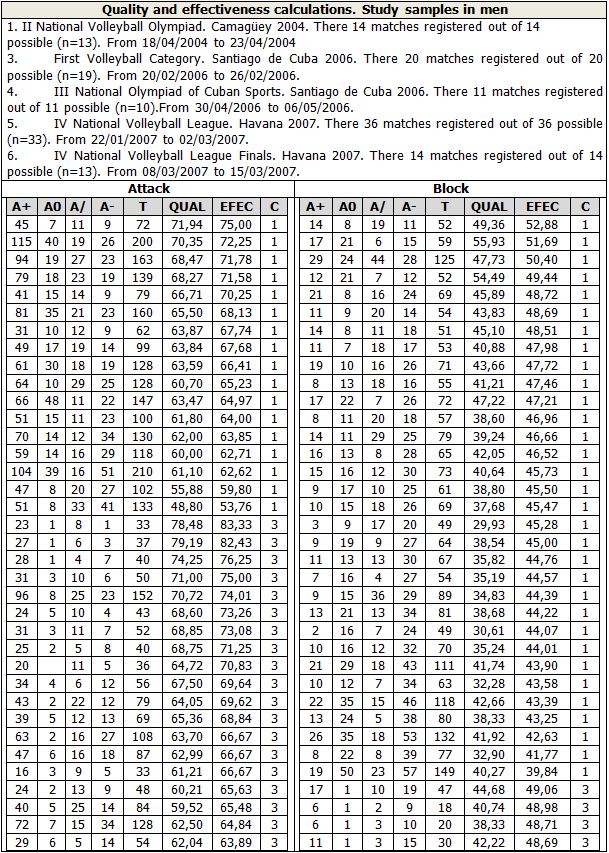
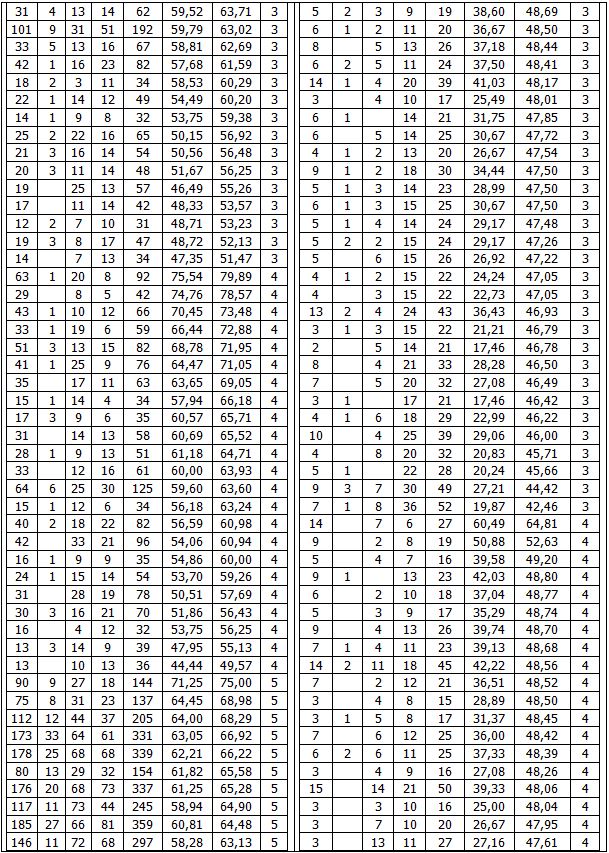
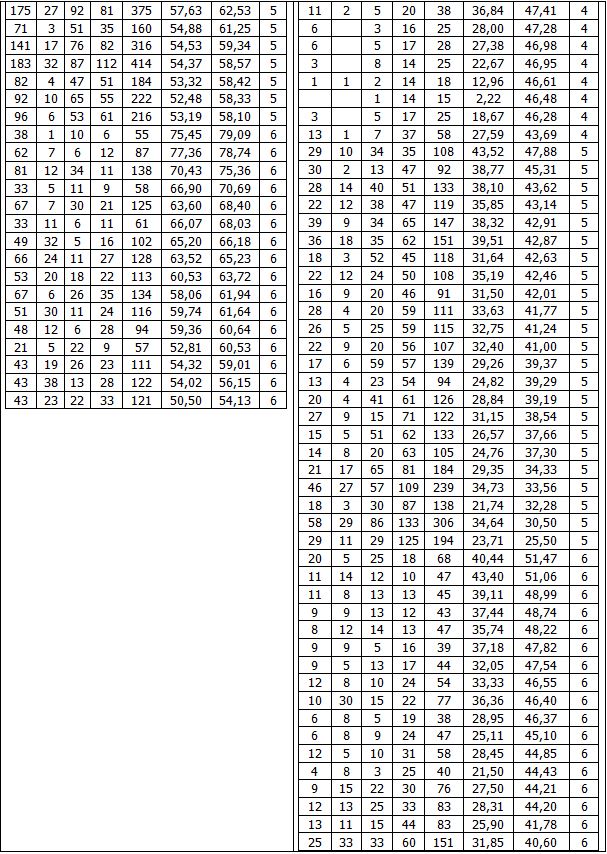
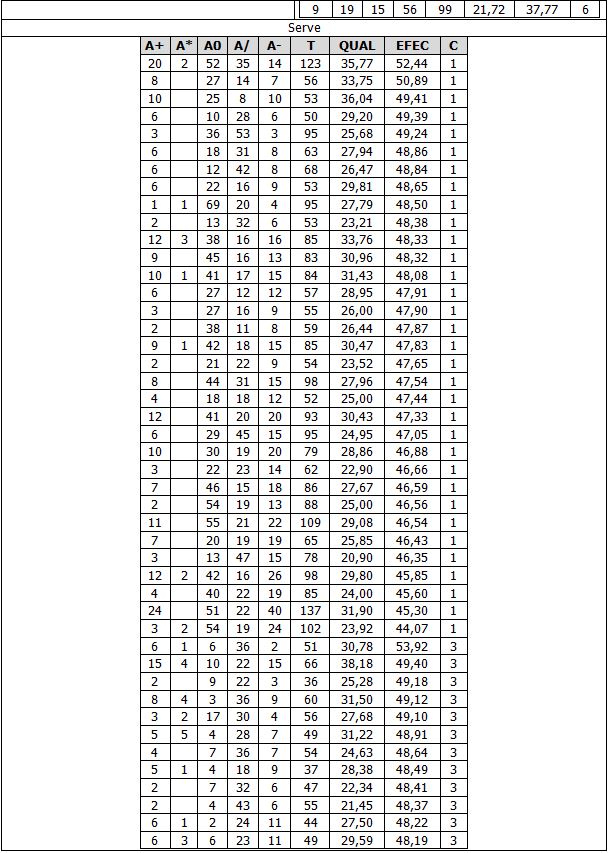
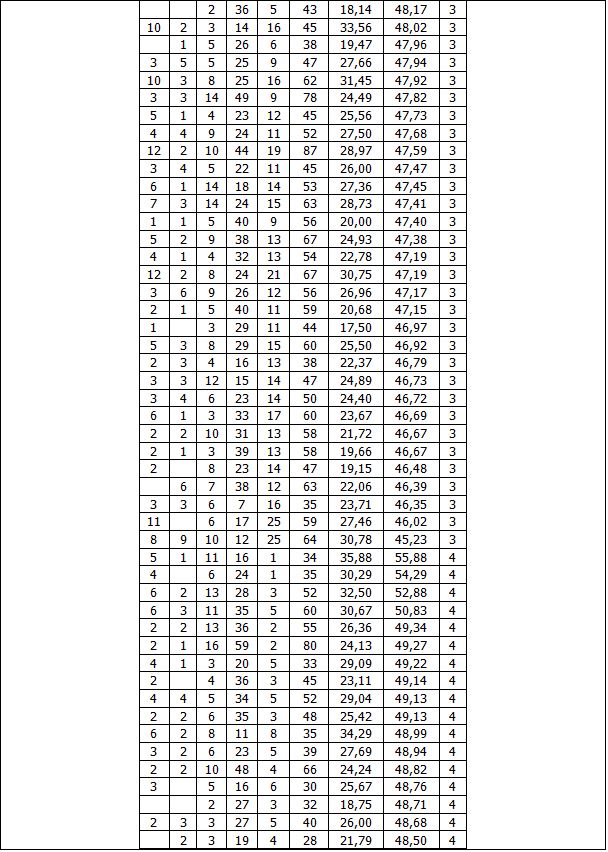
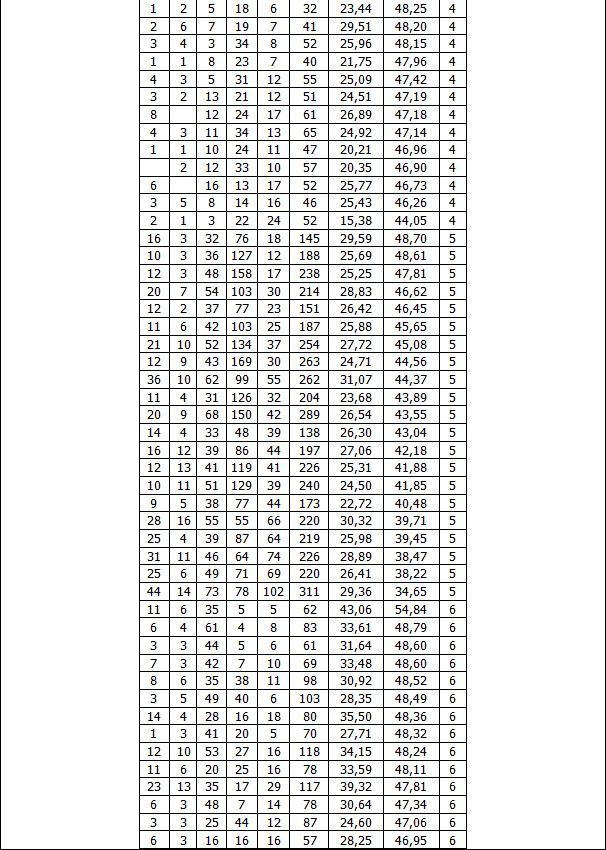

In the previous table, as in table 3, the data is organized taking into account the performance of the player during each tournament, presenting the numbers of each competition (C) set from one to six (in the case of men, championship number two is excluded due to unreliable data).
In table 2 are organized the values described in table 1, on which were applied the percentiles 90, 75, 50, 25; from which it was obtained an evaluation scale for the offensive technical and tactical skills in both genders, as part of the calculations made through the mathematical models of Effectiveness (EFEC) and Quality (Qual). In table 2 it is obtained a scale based in five qualitative scores. Example: the scale that evaluates the Attack skill in men declares that every player with a numerical indicator higher than 74.71 % can be evaluated as Excellent, while having a number higher than 69.34 % and equal to 74.71 % will be qualified as Very Good. On the other hand, if a player obtains a value higher than 65.90% and equal to 74.71% they will be evaluated as Good. If the numerical value surpasses 60.25 %, the evaluation will be Average, while obtaining a value lower than 60.25 % will give the qualification of Bad.
Table 2. Percentiles 90, 75, 50, 25 that divided the individual performance
reached according calculation models of Effectiveness and Quality. Men
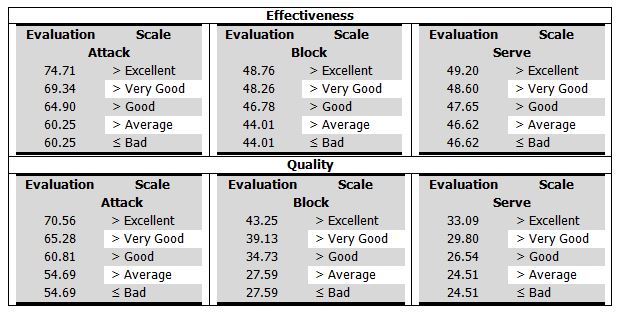
In table 2 the information is organized according to calculations made through mathematical models that process the variables of technical and tactical performance, they would be Effectiveness and Quality, according to Calero S., 2007a. Both models will be described in the second part of the paper.
In table 3 are organized the values described in women, on which were applied the percentiles 90, 75, 50, 25; obtaining an evaluation scale for the offensive technical and tactical skills from calculations made through mathematical models of Effectiveness (EFEC) and Quality (QUAL).
Table 3. Organized data of the individual technical and tactical performance of different players in championships held in Cuba according to calculations models of Effectiveness and Quality. Women
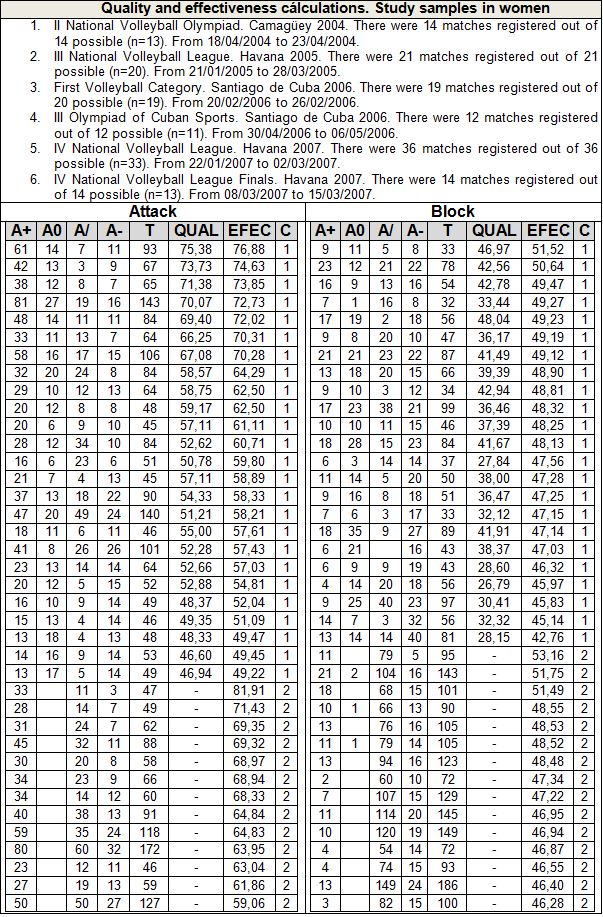
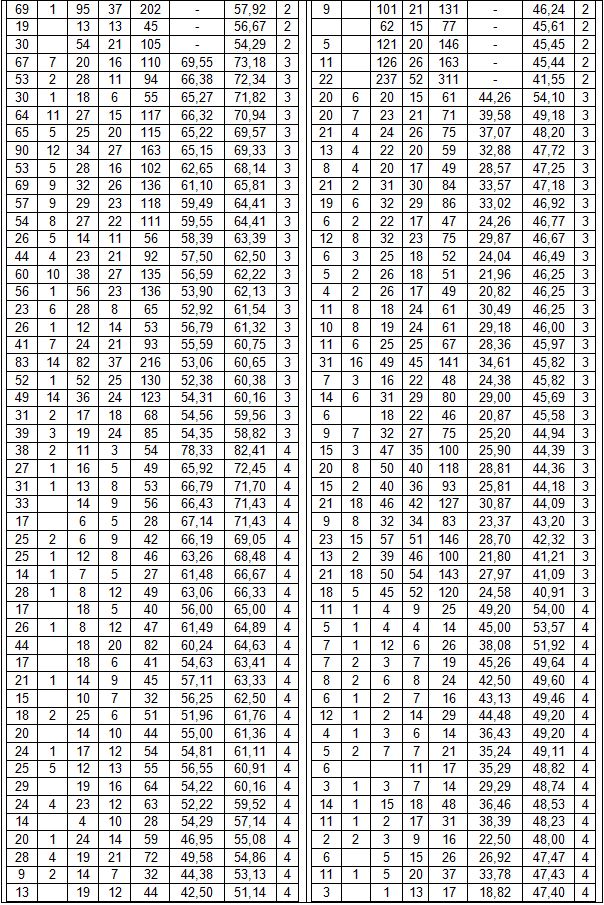
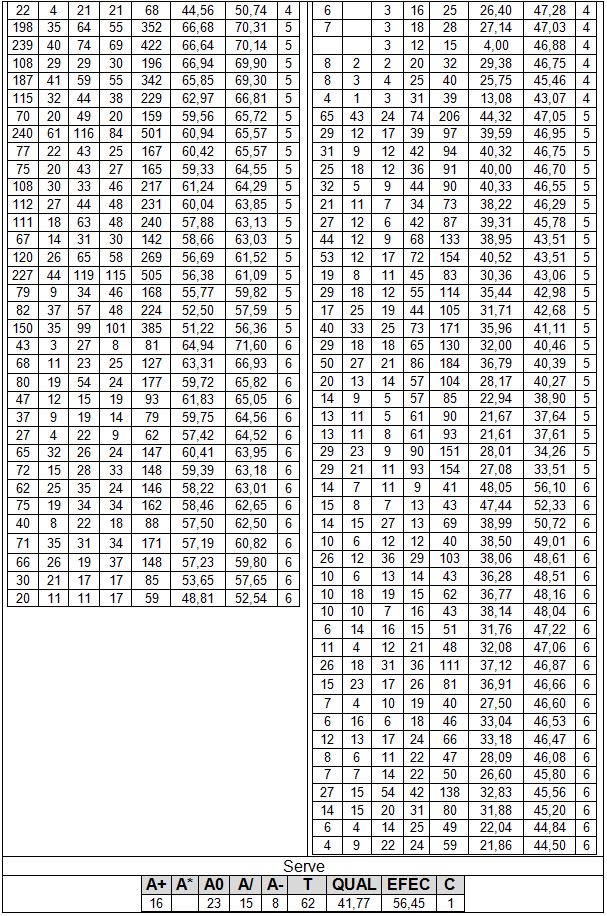
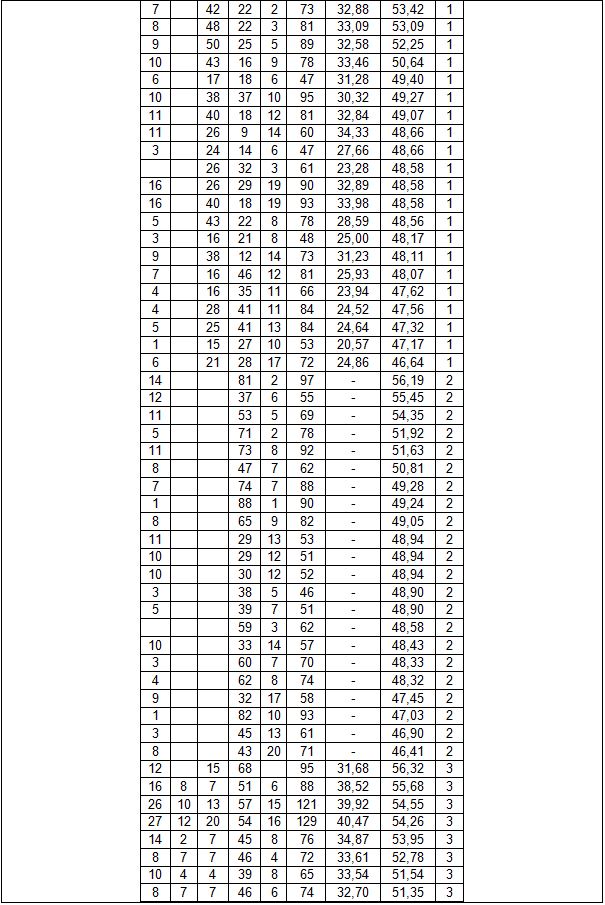
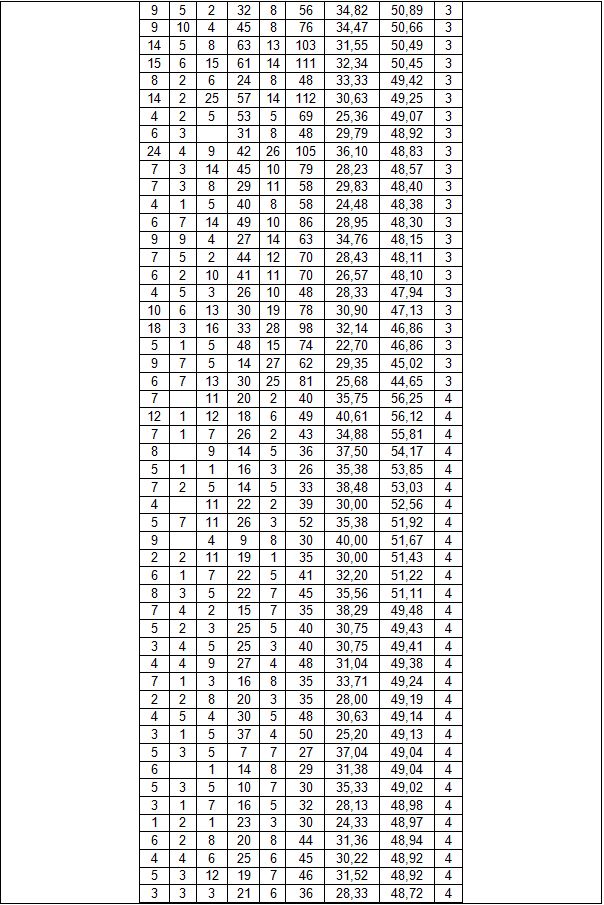
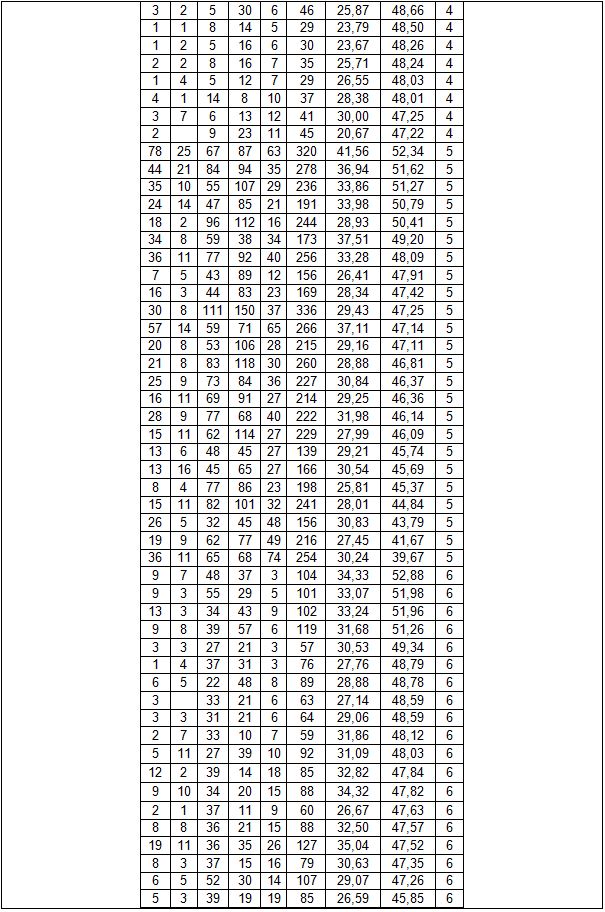
![]()
Table 3 describes the numerical values obtained and set in an ascending way from the chronological order of the competitions (C) and the Effectiveness (EFEC) calculations.
To evaluate the Serve skill, the Quality (Qual) calculations were only applied on competitions three, four, five and six, since the records of competitions one and two are not reliable enough, so they do not fulfil the requirements of the mathematic model. On the other hand, the evaluations of the Attack and Block skills for the Quality (Qual) calculations do not include competition two, for the same reasons previously explained. Nevertheless, all the competitions are valid for the calculation of the Effectiveness model.
Table 4. Percentiles 90, 75, 50, 25 that divide the individual performance reached according to calculation models of Effectiveness and Quality. Women
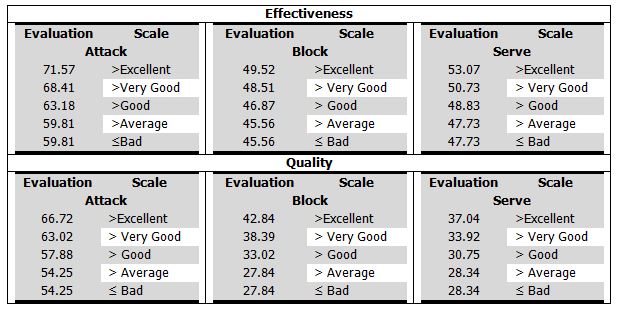
Table 4 describes the mathematical values obtained from the percentiles. In the case of the values obtained from the effectiveness calculations (EFEC, Tabla 3), it is noted that to reach the evaluation of Excellent every female player must have a numerical level higher than 71.57%, in Block Excellent must surpass 49.52% and in Serve over 53.07%. On the other hand, the Quality calculations scales (Qual, table 3) establish that to have the evaluation of Excellent in Attack, the level needed must surpass 66.72%, in the case of the Block skill over 42.84% and in Serve over 37.04%.
Both the data obtained in Table 1 and 3 were registered from observational methods used by the Cuban Volleyball Federation, which records the technical and tactical skills for high-performance volleyball, available in Calero S., 2009c.
The use of evaluation scales is subordinated to the process of sport training which depends on several factors closely related, for that reason, every information obtained is a value that conditions the decision-making process, but these are not the only elements to base decisions on, since the sport training as a multidisciplinary component needs much more comprehensive information, an aspect that makes possible to evaluate the performance o players and team in a more accurate way.
In the second part of the article we will basically show the mathematical models (Effectiveness and Quality) and the observation guide that methodologically describes and records the variables listed in tables 1 and 3, among other aspects.
Conclusions
The evaluation scales of the individual technical and tactical performance contribute to organizing the ideas that evaluate singularities from several approaches, allowing an optimized evaluation of each player.
Bibliography
-
Beal, D. (1990). Coupe du Monde 1989: évaluation techique. Volley Tech, v. 1, pp. 6-9.
-
Bouza, C.N y Sistachs, V. (2002). Estadística teoría básica y ejercicios. Editorial Félix Varela. La Habana, Cuba. pp. 7-15.
-
Calero, A. (2003). Estadística III. Editorial Félix Varela, La Habana, Cuba. pp.61
-
Calero, S. (2005). Sistema de registro y procesamiento del rendimiento técnico-táctico para el voleibol de alto nivel. Fragmentos publicados en: V Conferencia Internacional de Educación Física y Deportes. Facultad de Cultura Física “Nancy Uranga Romagoza” Pinar del Río. 15 de Abril del 2005. ISBN: 959-7133-51-2
-
Calero, S. (2006). Caracterización a través de escalas evaluativas del Voleibol Cubano de alto nivel. III Simposio Internacional de Voleibol. Santiago de Cuba, Cuba.
-
Calero, S. (2007a). Diseño de modelos matemático estadísticos para procesar rendimiento en los voleibolistas. I Curso Nacional sobre control del rendimiento en Voleibol y Voleibol Playa. Escuela Nacional de Voleibol y Escuela Internacional de Educación Física y Deportes (EIEFD), del 26 de mayo al 2 de junio del 2007. La Habana, Cuba
-
Calero, S. (2007b). Estadística aplicada para profesionales del Voleibol. Curso impartido en la Facultad de Cultura Física “Nancy Uranga Romagoza” de Pinar del Río. Federación Cubana de Voleibol. Pinar del Río, Cuba.
-
Calero, S. (2009a). Metodología observacional para el registro del rendimiento técnico-táctico del Voleibol de alto nivel. Curso de postgrado impartido en la Escuela Nacional de Voleibol. Federación Cubana de Voleibol y Escuela Internacional de Educación Física y Deportes (EIEFD) del 16 al 27 de Febrero del 2009. La Habana. Cuba.
-
Calero, S. (2009b). Las relaciones entre fundamentos del Voleibol: Aspecto básico que determina la cantidad e influencia de las acciones técnico-tácticas en el rendimiento final. EFDeportes.com, Revista Digital. Buenos Aires, Año 13. Número 129. http://www.efdeportes.com/efd129/voleibol-influencia-de-las-acciones-tecnico-tacticas-en-el-rendimiento-final.htm
-
Calero, S. (2009c). Guía operativa sobre metodología observacional para el registro del rendimiento técnico-táctico del voleibol de alto nivel. Federación Cubana de Voleibol. La Habana, Cuba. Registro 2742-2007 (CENDA).
-
Cintra O. (1989). Test pedagógico y baloncesto para todos. Editorial Pueblo y Educación. La Habana, Cuba. pp.1-5
-
Colectivo de autores (1987). Bioestadística y Computación. Instituto Superior De Ciencias Médicas de La Habana y Centro de Cibernética Aplicada a la Medicina. Editorial Pueblo y Educación. La Habana, Cuba. pp. 31-44.
-
ControlVolei, Competencia, 2007 v1 (2007) Software para el control del rendimiento técnico-táctico del Voleibol de alto nivel. Federación Cubana de Voleibol, La Habana. Cuba.
-
Diccionario Cervantes (2008). Cervantes: Diccionario manual de la lengua española. Editorial Pueblo y Educación. La Habana, Cuba.
-
Diccionario Encarta (2008) Microsoft® Encarta® 2009. © 1993-2008 Microsoft Corporation. USA.
-
Egaña, E. (2003). La estadística: Herramienta fundamental de la investigación pedagógica. Editorial Pueblo y Educación. La Habana, Cuba. pp.23-24.
-
Gerbrands, T. y Murphy, P. (1995). Consecuencias del cambio de la regla de Saque. Estudio teórico. Volley Tech 1 (Edición Española)
-
Lucas, J. (2000) Recepción, Colocación y Ataque en Voleibol. Editorial Paidotribo, Barcelona. España, pp.342-343; 209-211.
-
Miller, I.R y col (2005). Probabilidad y estadística para ingenieros. Editorial Félix Varela, La Habana, Cuba. pp.22-30.
-
Neville, W. (1994). Block. En Serve it up. Volleyball for Life. Mayfield Publishing Company. London, England. pp. 64-74.
-
Platonov V. (1994). El Bloqueo. International Volley-Tech, 4, pp.2-5.
-
Rubalcaba, L. (1997). Programa didáctico de Voleibol para escuelas de iniciación y desarrollo deportivo. Editorial Rodríguez, Litografía C.A (ROLICA) Maracaibo, Venezuela. pp. 74
-
Sawulla, L. (1990). Rapport technique de Coupe du Monde feminine au Japon. Volley-Tech, v. 1, pp. 10-13.
-
Simov, T. (1981). El Bloqueo Efectivo. VB. Federación Española de Voleibol, 24, pp.12-19.
-
Suárez, C. y Calero, S. (2007). El Sistema de Información del Voleibol Cubano. Curso impartido en la Facultad de Cultura Física “Nancy Uranga Romagoza” de Pinar del Río. Federación Cubana de Voleibol. Pinar del Río, Cuba.
-
Toyoda, H. (1991). Technical evaluation in the XXIIth Men's World Championships. International Volley Tech, v. 1, pp. 19-20.
Another articles in English

|
|
|---|---|
|
EFDeportes.com, Revista Digital · Año 21 · N° 217 | Buenos Aires,
Junio de 2016 |
|